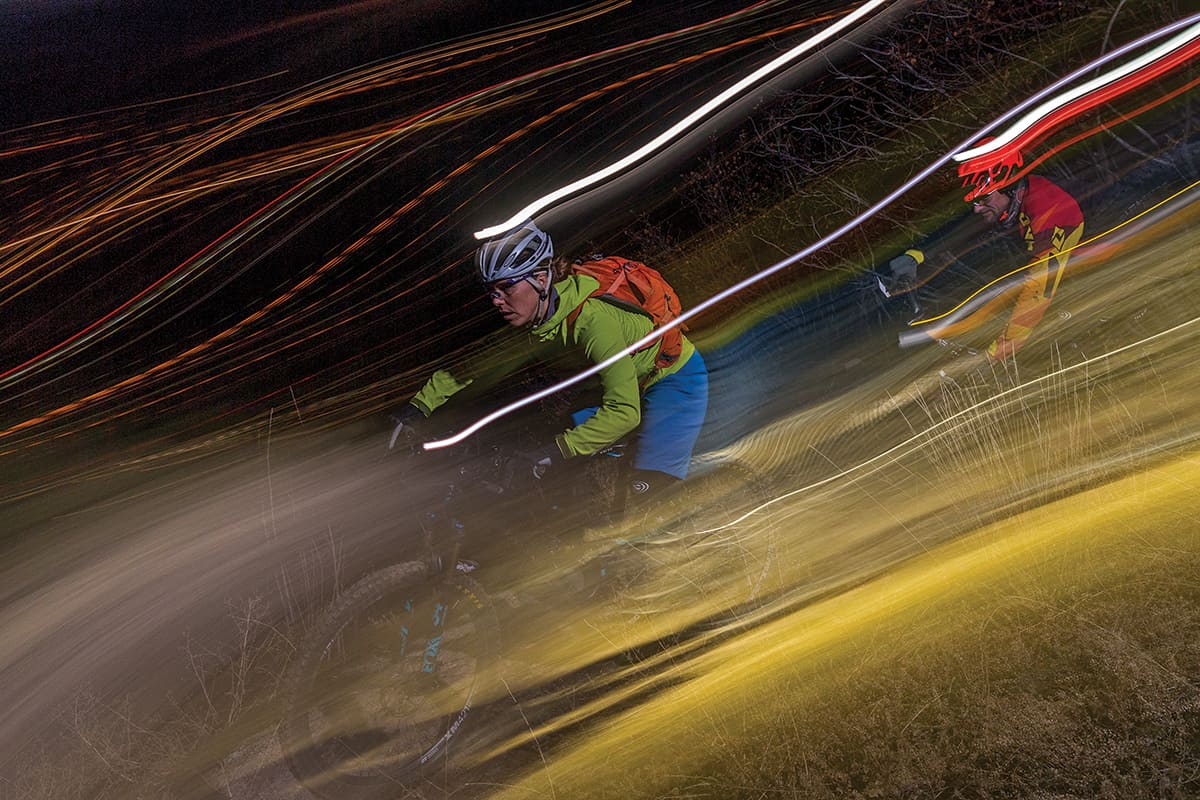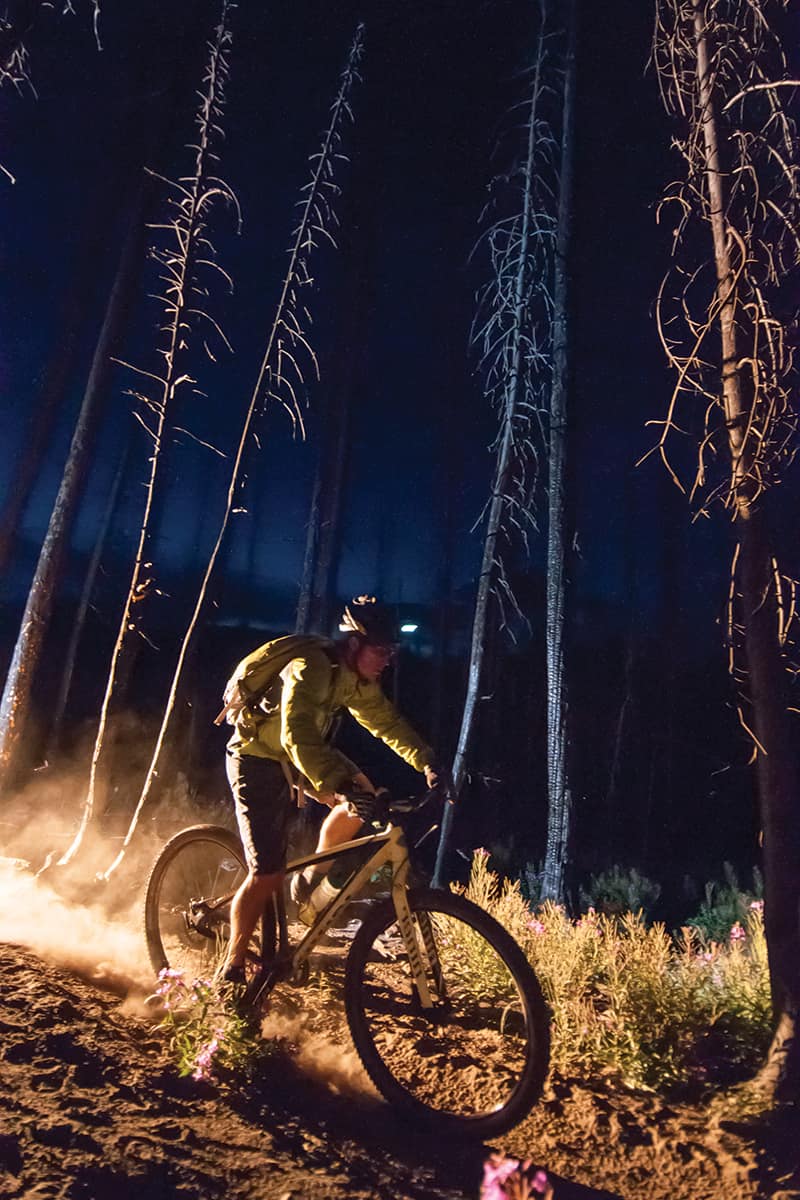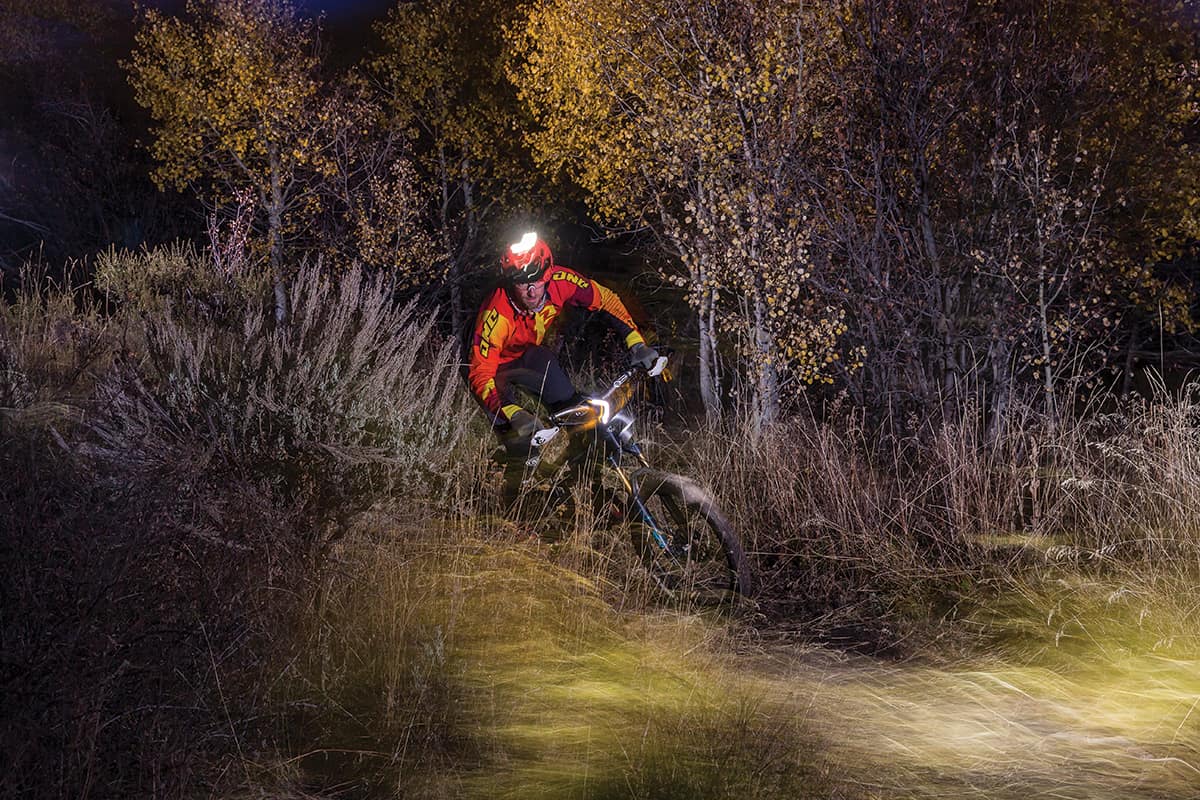Read The
Current Issue
Pedaling into the Night
Trade happy hour or, even better, an after-dinner drink for a mountain bike ride. The latter is done by headlamp, which makes it a totally unique experience.
By Mike Koshmrl

CARY SMITH, A national champion mountain biker who enjoys and excels at endurance events, began riding at night out of necessity—it was the only time he had to train. (Smith’s day job is as a dentist.) “Obviously it’s a necessity thing,” he says, “but I also do really enjoy it. The technology is really good and lights are really bright, and you can ride basically as fast as you can in the day. And it’s quiet. There’s nobody out there. It’s very nice.”
Sometimes the thing you want to help clear your head in the evening is silence. And perhaps a little bit of perspiration.
Since Jackson summer evenings often provide enough light to ride until past nine p.m., you don’t need a bright light to do a happy hour ride. On one of these, you can enjoy gorgeous light as the sun sinks behind the Tetons, casting a pinky-orange glow for much longer than you’d expect. But a post-dinner headlamp ride is, as Smith says, “very nice.” Smith has hit the trail after nightfall in places like Phillips and Black canyons off Teton Pass, and once even pulled off a through-the-night ride in the Mount Leidy Highlands, pedaling through grizzly bear territory from Ditch Creek out to the Horsetail trailhead off the Gros Ventre Road. He sees deer and elk regularly, a black bear once, and on one occasion on the pass had a near-collision with a large ungulate he thinks was a moose. “But that happens during the daytime, too,” Smith says. “My point of view is that it’s a great way to get out and use your forest. Everyone should try it.”
Here are a few places you can try it:
Phillips Ridge
Level: Intermediate+
Much of this nine-mile singletrack ride in the southern reaches of the Tetons traces the ridgeline that stands tall over Wilson and the Snake River’s west bank. Access it from a marked trailhead halfway up Teton Pass to make it a mostly downhill, one-way ride (gaining five hundred feet, but descending two thousand). The pace picks up as the trail gets closer to the valley floor, where it switchbacks down from the ridge through thick timber, eventually merging onto the Phillips Canyon Trail and descending all the way to paved Fish Creek Road. If you’re looking for more of a workout, you can start and end at the Fish Creek Road trailhead, making it an eighteen-mile out-and-back that climbs and descends equal amounts.
Why night? Perched two thousand feet over the valley, on a moonlit night Phillips Ridge offers a full display of a night-bright Jackson Hole.
Putt-Putt Trail
Level: Intermediate–
A local favorite day, dusk, and night, Putt-Putt is a three-mile (one-way) singletrack trail over a mix of treed and open slopes about two miles from downtown Jackson. (It has two starting points: at the Nelson Drive trailhead and the parking lot at the end of Cache Creek Road.) Wherever you start, expect well-graded, banked corners and some culling of obstacles—hikers are allowed on Putt-Putt, but the trail was built with mountain bikers in mind. On the way out, Putt-Putt gains more than three hundred feet but descends 750 feet. When this trail ends at the two-track Cache Creek Road, you’ve got several options, one of which is easy. We’ll start with the easy way: Roll onto the former road, now a two-track until it becomes a wide, dirt road about 1.5 miles above the parking lot. This route will take you right back to the Cache Creek parking lot. Another option is to turn around and ride back down the way you came. Option three is to link together singletrack on the south side of Cache Creek by crossing over the dirt road to the timbered Hagen Trail, which winds its way back to the Cache Creek parking lot. (This route does have several spurs, so if you want to do it we recommend you download trail maps of the area onto your phone for nighttime viewing.)
Why night? Dark is your only chance to have Putt-Putt to yourself. During the day it’s one of the most popular rides in the valley.
Game Creek
Level: Beginner
Five miles south of Jackson this old Forest Service road, which has devolved into a wide trail, is perfect for bikers looking for a nontechnical ride. Starting from an unremarkable trailhead several hundred yards up on the east side of Game Creek Road, it starts off as a wide two-track road, then transitions to a singletrack path after a couple of miles. Since this is an out-and-back you can turn around at any point. Most people go in about three miles. For a more strenuous ride, Game Creek can be linked to trails in the Cache Creek or West Game trail systems. Again, make sure you have trail maps if you do this. Also, both mountain bikers and runners have reported seeing mountain lions in this area, although no encounters have resulted in bloodshed. (FYI, mountain lions live in all the mountains around Jackson Hole; they’ve just been reported being seen here most often.)
Why night? If there’s something more relaxing and magical than moonlight reflecting off Game Creek, which the trail parallels for some time from the trailhead, we have yet to discover it.
Light Bright
The biggest factor in helping avert unwanted encounters with animals large and small is a light. Really, really bright ones. The Hub Bicycles owner Hal Wheeler, who slings several models at his shop, explains that handlebar- or helmet-mounted devices cast a beam that’s every bit as powerful as ordinary car headlights, and exposes every rock, drop-off, and gleam from an animal’s eyes with ease. “The 1,500 to 2,000 lumen range is what’s bright enough to make it as safe as riding during the day,” he says.
The Other Side of the Story
Jackson Hole Wildlife Foundation co-founder Lorna Miller first became aware of bikers riding with headlamps when she was “flabbergasted” to see bright lights moving down the Hagen Trail through the trees on the flank of Snow King Mountain. She sees nighttime use of Cache Creek as another gash in wildlife habitat that’s perpetually under assault: The local critters once had the night to themselves, and now they don’t. “We’re encroaching constantly,” Miller says. “We’re nibbling them to death. I’m not saying it’s outrageous right now, but if that’s the trend, who’s to say what it’s going to get like? If we’re really serious about wildlife and we’re going to walk the talk on wildlife, we need to be conscious of these things.”
Land managers are also concerned about the chance of surprise encounters with wildlife. “Animals are more likely to be bedded down at night and their sight range is much more limited,” says Bridger-Teton National Forest recreation manager Linda Merigliano. “So, the likelihood of running into a critter in close proximity is much higher.” But when it comes to preventing conflicts between trail users and wildlife, Merigliano’s worries turn to more pressing matters than night biking. People running inattentively while wearing ear buds, badly behaving dogs, and hikers violating wildlife-closure areas are all more pervasive problems, she says.






